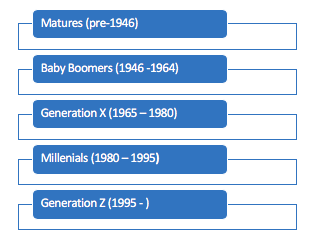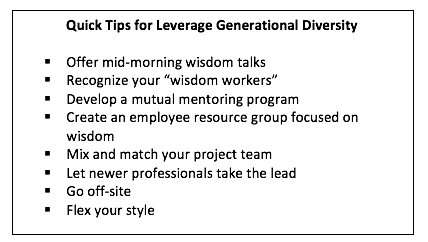Leveraging Generational Diversity at Work
June 27, 2019 in Diversity & Inclusion
By Kathleen Bellis
As we wind down this month’s focus on diversity and inclusion, we had one more conversation to share about diversity in the workplace- a point of view on generational differences that highlights the true differences, as well as the powerful commonalities between the four different generations currently at work together.

Have you ever heard, or said, any of these?
- “I don’t expect to be at the same organization for the rest of my career.”
- “You can’t take people with nose rings seriously at work.”
- “Technology is overrated; it’s face-to-face communication that has the greatest impact.”
- “Just because the boss works long hours doesn’t mean we employees have to.”
- “If a section of a meeting doesn’t apply to you, there is nothing wrong with checking e-mail on your phone.”
- “It’s not about how many hours you work, as long as you get your work done.”
- “People should be in their organizations at least six months to a year before they start trying to change things.”
- “There are very few work emergencies worth working late for.”
These statements illustrate the generational friction that is inevitable today because we have never before had four generations in the workplace: Baby Boomers, Generation X, Millennials, and Generation Z. People are living longer, there has been a huge acceleration in the speed of technology, and younger generations are more visible and are participating more actively.

The Pew Research Center discovered that 79 percent of the public sees a generation gap, defined as “major differences . . . in the point of view of younger and older adults.” That’s five percentage points higher than when Gallup asked the question in 1969. Hayden Shaw, in his book “ Sticking Points” outlines research that indicates differences in such things as communication, decision making, dress code, feedback, fun at work, knowledge transfer, loyalty, meetings, policies, respect, training, and work ethic.
Though it can be a challenge, there are many benefits of generations working together:
- A generationally diverse workforce is better equipped to respond to today’s high-flux and disruption-prone marketplace.
- More perspectives on a team lead to better decision making.
- It is nearly impossible to learn something new from someone who is just like you.
- Diversity of thought spurs innovation.
- A diverse team provides the opportunity for the unique strengths of each team member to be leveraged.
So, how do you get the four generations in your workplace to get past any differences and work together? How do you leverage the differences and look at the for the opportunities they are?
Keep in mind that generational differences may not always be due to age. In a massive study by the Hay Group, a global management consulting firm, researchers analyzed data from over 5 million employees across the world to make comparisons across different generations. Not surprisingly, they found that generational differences are more likely to reflect the stage of development of employees, as opposed to their generation. In other words, the differences between Millennials versus Boomers may reflect changes in perceptions and expectations due to their age and career stage, rather than generational thinking or values.
In other cases, some people may emphasize generational differences too much. Jennifer J. Deal, a research scientist with the Center for Creative Leadership found that:
- All generations have similar values. For example, family tops the list for all of the generations. The most striking result of the research, Deal says, is how similar the generations are in the values that matter most.
- Everyone wants respect. Everyone wants respect, but the generations don’t define it in the same way. In the study, older individuals talked about respect in terms of “giving my opinions the weight I believe they deserve,” while younger respondents characterized respect as “listen to me, pay attention to what I have to say.”
- Leaders must be trustworthy. Different generations do not have notably different expectations of their leaders. Above all else, people of all generations want leaders they can trust.
- Nobody likes change. The stereotype is that older people resist change while younger people embrace it. These assumptions don’t stand up under the research, which found that people from all generations are uncomfortable with change. Resistance to change has nothing to do with age; it has to do with how much you stand to gain or lose as a result of the change.
- Loyalty depends on context. It is said that younger generations are not as loyal to their organizations as older workers. But the research shows, for example, that the amount of time a worker puts in each day has more to do with his or her level in the organization than with age. The higher the level, the more hours worked.
- Everyone wants to learn. Learning and development were among the issues brought up most frequently by people of all generations. Everyone wants to learn and to ensure they have the training to do their job well.
- Everyone likes feedback. According to the research, everyone wants to know how they are doing and to learn how they can do better.
Remember that leadership starts with understanding. Hayden Shaw points out the following ways to leverage our similarities and our generational diversity at work.
- Acknowledge: Talk about generational differences.
- Appreciate:Focus on the “why,” not the “what,” and the common needs.
- Flex:Agree on how to accommodate different approaches.
- Leverage:Maximize the strengths of each generation.
- Resolve:Determine which option will yield the best results (when flexing isn’t enough).
Consider trying some of these quick tips for getting started:
